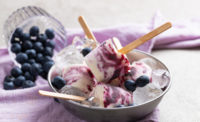
The laws of chemistry and physics have not changed since the Big Bang. Not all these laws are known, and we continually learn more, leveraging novel approaches, processes, and/or formulations to create truly new products.
This includes additions to our ingredient toolbox. Throughout the past few decades, we have reduced, replaced or omitted fat in frozen desserts to mixed results related to manufacturing, eating quality and resistance to heat shock. The same seems to be true with efforts to reduce “sugars” (e.g., no sugar added, sugar-free formulations.)
A new question: Is it possible to formulate a low-calorie (< 40 kilocalories per serving) frozen dessert given current our knowledge, capabilities and ingredients?
A quick look back
First, some history. In 2005, in this very space, Bruce Tharp and Steven Young introduced the concept of true sugar-free (< 0.5 gram total “sugars,” inherently lactose-free) frozen dairy dessert that could be manufactured, distributed, stored, sold and consumed without the need for high-intensity sweeteners or combinations thereof. At the time, a secondary objective was a caloric target of approximately 100 kilocalories per 4-fluid-ounce serving, consistent with 100-kilocalorie snack packs being marketed at the time.
Since then, the serving size for frozen desserts increased to 2/3 cup (5.33 fluid ounces), and a series of new ingredients is now available, including novel (and improved) high-intensity sweeteners. In addition, allulose, a rare sugar, received generally recognized as safe (GRAS) approval.
With these novel ingredient choices, can the concept of a true sugar-free frozen dessert be extended to achieve a true low-calorie (< 40 kilocalories per 5.33-fluid-ounce serving) objective?
Some considerations
Not to dismiss the availability nor the sweetness quality of new high-intensity sweeteners and combinations thereof, but let’s delay consideration of these to “top off” any missing sweetness that might be needed later.
There are two “rare” sugars to consider: allulose (an isomer of glucose and fructose) and tagatose (an isomer of glucose and the galactose moiety of lactose.) Both are monosaccharides found in nature in “rare” amounts and are slightly less sweet than sucrose. Due to their metabolic natures, they are ultra-low in caloric contributions.
For now, only allulose is GRAS and applicable to frozen desserts. Allulose is classified as a carbohydrate, but again, due to its metabolic nature, adds only 0.4 kilocalorie per gram and is neither a “sugar” nor an “added sugar” for nutrition-labeling purposes.
There is one conundrum within allulose’s GRAS status. As we read the GRAS petition (approved as is without comment nor question by FDA), there is no specified limit to the use of allulose in terms of grams per serving as with select other sweeteners such as sugar alcohols. There is only the apparent, or assumed, “limit” of 5%, by weight, based on the estimated ingestion rate of allulose in the general population via all frozen desserts, all volumes.
Consider, the following:
- A 5% (by weight) use rate in standard ice creams at the minimum 4.5 pounds per gallon = 4.25 grams allulose per 5.33-fluid-ounce serving.
- A 5% (w/w) use rate limit in standard ice cream at 7.5 pounds per gallon (~20% overrun; think “superpremium”) = 7.13 grams allulose per 5.33-fluid-ounce serving. If this amount of allulose is consistent with its GRAS status, then apply 7.13 grams per serving to a low-fat (< 3 grams total fat per serving) frozen dessert at an allowed minimum 4.0 pounds per gallon = 9.1% allulose.
Oops!
The good news is that we already know how to use allulose (and tagatose, for that matter, in advance of its GRAS status) from decades using high-fructose corn sweeteners and various other monosaccharides and sugar alcohols in frozen desserts. We can even compare use to that true sugar-free formula from 2005.
As you can see in the table below, none of the alternatives is quite “low calorie” (< 40 kilocalories per serving).
Where could further reductions be found? Consider serving-size reduction via single-serve units (e.g., 3-fluid-ounce cups; 2-fluid-ounce cups/bars.) For example, Alt. 3 in the table in a 3-fluid-ounce cup nets 29 kilocalories and is both sugar-free and low calorie! Now, recalculate grams of allulose per the new serving size: 76 grams x 0.16 x (3.00/5.33) = 6.8 grams allulose. Are the numbers starting to look familiar?
As needed, “top-off” sweetness from one, or better yet, a combination of, appropriately selected high-intensity sweeteners. The mixes should remain more “sucrose-like” in sweetness per flavor.
How about digestion-resistant maltodextrin (DRM)? DRM is a water-soluble dietary fiber that, at 6.8 grams per 3 fluid ounces, provides an “excellent source” (20+% daily value) of dietary fiber! A column for another day.
All of the above can be extended into nonstandard dairy and plant-based frozen desserts. The same chemistry and physics apply. Mother Nature would be proud.

For more about reduced-sugar, low-sugar, no-sugar-added and sugar-free products, including kilocalorie management, plan to attend the 50th Edition of “Tharp & Young on Ice Cream Technical Short Course, Workshops, and Clinics,” Dec. 1-3, 2021, Las Vegas, Nevada. For registration, discounts, and more, go to www.onicecream.com or call Steven Young, Ph.D., at 281-782-4536.




